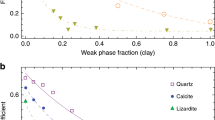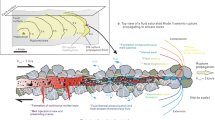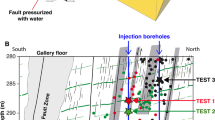Abstract
Despite the hazard posed by earthquakes, we still lack fundamental understanding of the processes that control fault lubrication behind a propagating rupture front and enhance ground acceleration. Laboratory experiments show that fault materials dramatically weaken when sheared at seismic velocities (>0.1 m s−1). Several mechanisms, triggered by shear heating, have been proposed to explain the coseismic weakening of faults, but none of these mechanisms can account for experimental and seismological evidence of weakening. Here we show that, in laboratory experiments, weakening correlates with local temperatures attained during seismic slip in simulated faults for diverse rock-forming minerals. The fault strength evolves according to a simple, material-dependent Arrhenius-type law. Microstructures support this observation by showing the development of a principal slip zone with textures typical of sub-solidus viscous flow. We show evidence that viscous deformation (at either sub- or super-solidus temperatures) is an important, widespread and quantifiable coseismic lubrication process. The operation of these highly effective fault lubrication processes means that more energy is then available for rupture propagation and the radiation of hazardous seismic waves.
This is a preview of subscription content, access via your institution
Access options
Access Nature and 54 other Nature Portfolio journals
Get Nature+, our best-value online-access subscription
$29.99 / 30 days
cancel any time
Subscribe to this journal
Receive 12 print issues and online access
$259.00 per year
only $21.58 per issue
Buy this article
- Purchase on Springer Link
- Instant access to full article PDF
Prices may be subject to local taxes which are calculated during checkout




Similar content being viewed by others
Data availability
The mechanical data used for Figs. 1 and 4 are archived on Zenodo at https://doi.org/10.5281/zenodo.4639947. All data are available from the authors on request. Source data are provided with this paper.
References
Global Death Toll Due to Earthquakes from 2000 to 2015 (Statista Research Department, 2016); https://www.statista.com/statistics/263108/global-death-toll-due-to-earthquakes-since-2000/
Kanamori, H. & Rivera, L. in Earthquakes: Radiated Energy and the Physics of Faulting (eds Abercrombie, R. et al.) 3–13 (AGU, 2006).
Nielsen, S. et al. G: fracture energy, friction and dissipation in earthquakes. J. Seismol. 20, 1187–1205 (2016).
Di Toro, G. et al. Fault lubrication during earthquakes. Nature 471, 494–499 (2011).
Goldsby, D. L. & Tullis, T. E. Flash heating leads to low frictional strength of crustal rocks at earthquake slip rates. Science 334, 216–218 (2011).
Hirose, T. & Shimamoto, T. Growth of molten zone as a mechanism of slip weakening of simulated faults in gabbro during frictional melting. J. Geophys. Res. 110, B05202 (2005).
Scholz, C. H. & Christopher, H. The Mechanics of Earthquakes and Faulting (Cambridge Univ. Press, 2002).
Noda, H. & Lapusta, N. Stable creeping fault segments can become destructive as a result of dynamic weakening. Nature 493, 518–521 (2013).
Rice, J. R. Flash heating at asperity contacts and rate-dependent friction. Eos Trans. AGU 80, F6811 (1999).
Di Toro, G., Hirose, T., Nielsen, S., Pennacchioni, G. & Shimamoto, T. Natural and experimental evidence of melt lubrication of faults during earthquakes. Science 311, 647–649 (2006).
Spray, J. G. Frictional melting processes in planetary materials: from hypervelocity impact to earthquakes. Annu. Rev. Earth Planet. Sci. 38, 221–254 (2010).
Hayward, K. S., Hawkins, R., Cox, S. F. & Le Losq, C. Rheological controls on asperity weakening during earthquake slip. J. Geophys. Res. Solid Earth 124, 12736–12762 (2019).
Rice, J. R. Heating and weakening of faults during earthquake slip. J. Geophys. Res. Solid Earth 111, B05311 (2006).
Viesca, R. C. & Garagash, D. I. Ubiquitous weakening of faults due to thermal pressurization. Nat. Geosci. 8, 875–879 (2015).
Reches, Z. & Lockner, D. A. Fault weakening and earthquake instability by powder lubrication. Nature 467, 452–455 (2010).
Han, R., Hirose, T. & Shimamoto, T. Strong velocity weakening and powder lubrication of simulated carbonate faults at seismic slip rates. J. Geophys. Res. Solid Earth 115, B03412 (2010).
Di Toro, G., Goldsby, D. L. & Tullis, T. E. Friction falls towards zero in quartz rock as slip velocity approaches seismic rates. Nature 427, 436–439 (2004).
Sulem, J. & Famin, V. Thermal decomposition of carbonates in fault zones: slip-weakening and temperature-limiting effects. J. Geophys. Res. 114, B03309 (2009).
Green, H. W., Shi, F., Bozhilov, K., Xia, G. & Reches, Z. Phase transformation and nanometric flow cause extreme weakening during fault slip. Nat. Geosci. 8, 448–489 (2015).
De Paola, N., Holdsworth, R. E., Viti, C., Collettini, C. & Bullock, R. Can grain size sensitive flow lubricate faults during the initial stages of earthquake propagation? Earth Planet. Sci. Lett. 431, 48–58 (2015).
Pozzi, G., De Paola, N., Nielsen, S. B., Holdsworth, R. E. & Bowen, L. A new interpretation for the nature and significance of mirror-like surfaces in experimental carbonate-hosted seismic faults. Geology 46, 583–586 (2018).
Pozzi, G. et al. Coseismic ultramylonites: an investigation of nanoscale viscous flow and fault weakening during seismic slip. Earth Planet. Sci. Lett. 516, 164–175 (2019).
Nielsen, S., Di Toro, G., Hirose, T. & Shimamoto, T. Frictional melt and seismic slip. J. Geophys. Res. Solid Earth 113, B01308 (2008).
De Paola, N. et al. Fault lubrication and earthquake propagation in thermally unstable rocks. Geology 39, 35–38 (2011).
De Paola, N. et al. The geochemical signature caused by earthquake propagation in carbonate-hosted faults. Earth Planet. Sci. Lett. 310, 225–232 (2011).
De Paola, N., Faulkner, D. R. & Collettini, C. Brittle versus ductile deformation as the main control on the transport properties of low-porosity anhydrite rocks. J. Geophys. Res. 114, B06211 (2009).
Buijze, L., Niemeijer, A. R., Han, R., Shimamoto, T. & Spiers, C. J. Friction properties and deformation mechanisms of halite(-mica) gouges from low to high sliding velocities. Earth Planet. Sci. Lett. 458, 107–119 (2017).
Thieme, M., Demouchy, S., Mainprice, D., Barou, F. & Cordier, P. Stress evolution and associated microstructure during transient creep of olivine at 1000–1200 °C. Phys. Earth Planet. Inter. 278, 34–46 (2018).
Gasc, J., Demouchy, S., Barou, F., Koizumi, S. & Cordier, P. Creep mechanisms in the lithospheric mantle inferred from deformation of iron-free forsterite aggregates at 900–1200 °C. Tectonophysics 761, 16–30 (2019).
Sibson, R. H. Fault rocks and fault mechanisms. J. Geol. Soc. Lond. 133, 191–213 (1977).
Brantut, N. & Platt, J. D. in Fault Zone Dynamic Processes: Evolution of Fault Properties During Seismic Rupture (eds Thomas, M. Y. et al.) 171–194 (AGU, 2017); https://doi.org/10.1002/9781119156895.ch9
Ashby, M. F. & Verrall, R. A. Diffusion-accommodated flow and superplasticity. Acta Metall. 21, 149–163 (1973).
Dygert, N., Bernard, R. E. & Behr, W. M. Great basin mantle xenoliths record active lithospheric downwelling beneath central Nevada. Geochem. Geophys. Geosyst. 20, 751–772 (2019).
Wheeler, J. Anisotropic rheology during grain boundary diffusion creep and its relation to grain rotation, grain boundary sliding and superplasticity. Philos. Mag. 90, 2841–2864 (2010).
Miyazaki, T., Sueyoshi, K. & Hiraga, T. Olivine crystals align during diffusion creep of Earth’s upper mantle. Nature 502, 321–326 (2013).
Poirier, J.-P. Creep of Crystals. High-Temperature Deformation Processes in Metals, Ceramics and Minerals (Cambridge Univ. Press, 1985); https://doi.org/10.1007/978-0-387-09751-0_26
Barnhoorn, A., Bystricky, M., Burlini, L. & Kunze, K. The role of recrystallisation on the deformation behaviour of calcite rocks: large strain torsion experiments on Carrara marble. J. Struct. Geol. 26, 885–903 (2004).
De Bresser, J. H. P., Ter Heege, J. H. & Spiers, C. J. Grain size reduction by dynamic recrystallization: can it result in major rheological weakening? Int. J. Earth Sci. 90, 28–45 (2001).
Kohlstedt, D. L. in Treatise on Geophysics Vol. 2 (ed. Price, G. D.) 389–417 (Elsevier, 2007).
Mackwell, S. J. & Paterson, M. S. New developments in deformation studies: high-strain deformation. Rev. Mineral. Geochem. 51, 1–19 (2002).
Frost, H. J. & Ashby, M. F. Deformation-Mechanism Maps: The Plasticity and Creep of Metals and Ceramics (Pergamon Press, 1982).
Schmid, S. M., Boland, J. N. & Paterson, M. S. Superplastic flow in finegrained limestone. Tectonophysics 43, 257–291 (1977).
Pieri, M., Burlini, L., Kunze, K., Stretton, I. & Olgaard, D. L. Rheological and microstructural evolution of Carrara marble with high shear strain: results from high temperature torsion experiments. J. Struct. Geol. 23, 1393–1413 (2001).
Wang, Q. Homologous temperature of olivine: implications for creep of the upper mantle and fabric transitions in olivine. Sci. China Earth Sci. 59, 1138–1156 (2016).
Handy, M. R. The energetics of steady state heterogeneous shear in mylonitic rock. Mater. Sci. Eng. A 175, 261–272 (1994).
Philpotts, A. R., Anthony R. & Ague, J. J. Principles of Igneous and Metamorphic Petrology (Cambridge Univ. Press, 2009).
Yao, L., Ma, S., Platt, J. D., Niemeijer, A. R. & Shimamoto, T. The crucial role of temperature in high-velocity weakening of faults: experiments on gouge using host blocks with different thermal conductivities. Geology 44, 63–66 (2016).
Acknowledgements
We thank B. Mendis, L. Bowen and F. Barou for their assistance with the acquisition of SEM and TEM images and discussion, and A. Beeby for acquiring Raman spectra on our samples. This project has received funding from the European Union’s Horizon 2020 research and innovation programme under the Marie Sklodowska-Curie grant agreement no. 642029 - ITN CREEP to N.D.P. and the Natural Environment Research Council (NERC) through a NERC standard grant NE/H021744/1 to N.D.P.
Author information
Authors and Affiliations
Contributions
G.P. ran the experiments and carried out the microstructural analysis and interpretations. G.P., N.D.P., S.B.N., R.E.H. and T.T. contributed equally to the concept development and to the writing of the paper. All authors jointly supervised this work.
Corresponding authors
Ethics declarations
Competing interests
The authors declare no competing interests.
Additional information
Peer review information Nature Geoscience thanks Stephen F. Cox and the other, anonymous, reviewer(s) for their contribution to the peer review of this work. Primary Handling Editor: Stefan Lachowycz.
Publisher’s note Springer Nature remains neutral with regard to jurisdictional claims in published maps and institutional affiliations.
Supplementary information
Supplementary Information
Supplementary Sections I–VI, Figs. 1–16, Tables 1 and 2, and Equations 1–7.
Source data
Source Data Fig. 1
Tabulated mechanical data.
Source Data Fig. 4
Tabulated mechanical data.
Rights and permissions
About this article
Cite this article
Pozzi, G., De Paola, N., Nielsen, S.B. et al. Coseismic fault lubrication by viscous deformation. Nat. Geosci. 14, 437–442 (2021). https://doi.org/10.1038/s41561-021-00747-8
Received:
Accepted:
Published:
Issue Date:
DOI: https://doi.org/10.1038/s41561-021-00747-8
This article is cited by
-
Physical state of water controls friction of gabbro-built faults
Nature Communications (2023)



